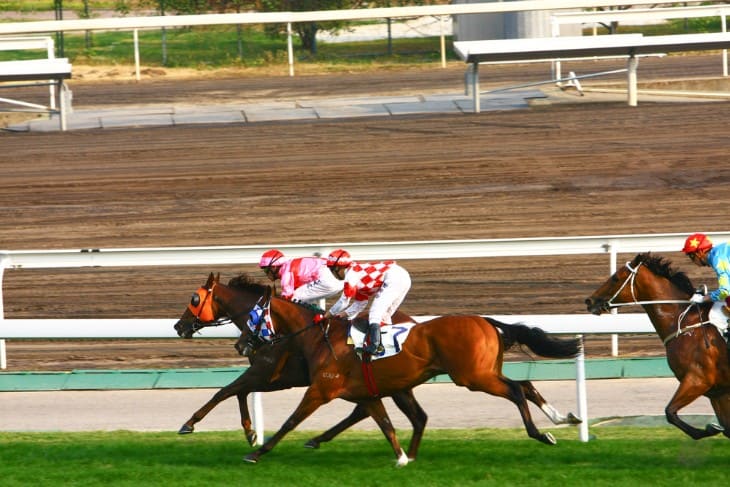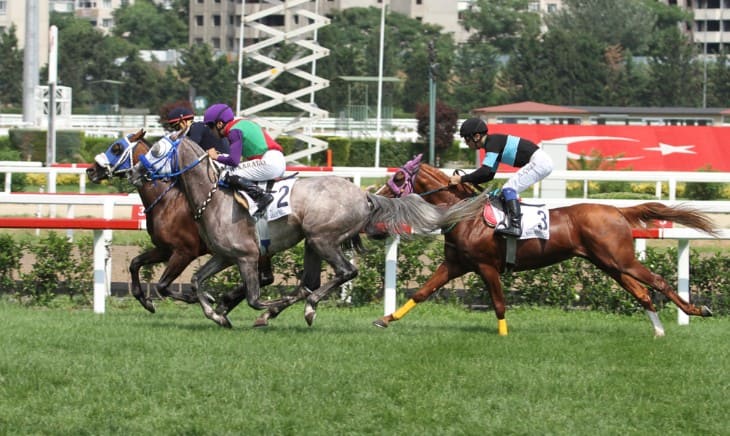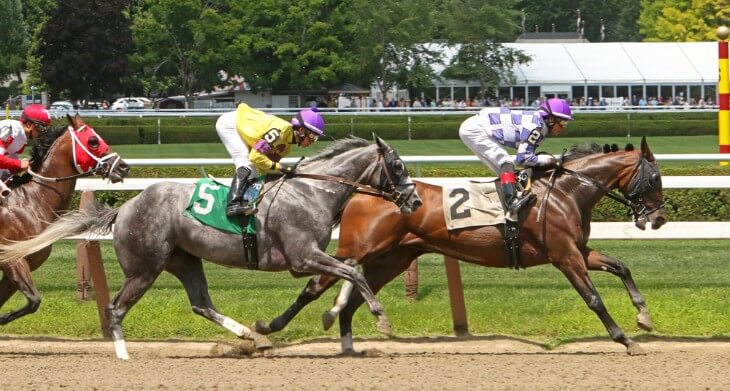In the heart-pounding world of horse racing, where speed, strategy, and synergy between horse and jockey reign supreme, one often overlooked yet pivotal factor plays a silent role in determining victory: posture. As the thundering hooves of magnificent steeds echo on the track and the eyes of the crowd fixate on the spectacle before them, the graceful alignment of a jockey's body on the horse becomes an artful dance of communication, balance, and finesse. Much like a conductor guiding an orchestra, the jockey's posture orchestrates a symphony of control, power, and harmony between rider and horse. Join us as we delve into the intricate tapestry of horse racing, where the seemingly simple act of maintaining a proper stance becomes the cornerstone of triumph, safety, and the thrilling pursuit of the winner's circle.
Communication and Control
Effective communication between the jockey and the horse relies on the unspoken language of posture. A jockey's posture serves as a conduit for conveying cues and commands to their equine partner. Through subtle shifts in weight, adjustments in body angle, and the position of their hands, skilled jockeys communicate a wide range of instructions that guide the horse's actions. Whether urging for acceleration with a slight lean forward or signalling controlled deceleration with a gentle pull of the reins, proper posture creates a seamless dialogue, enabling precise control over the horse's speed, direction, and responses to the ever-changing race conditions.
Amid the flurry of pounding hooves and the gusts of wind, maintaining balance and stability is essential for both jockey and horse. The jockey's posture acts as a fulcrum, maintaining delicate equilibrium. By centring their weight and aligning their body, the jockey evenly distributes their pressure across the horse's back. This balance not only prevents strain on specific muscle groups but also equips the jockey to manage sharp turns and unexpected obstacles. A well-maintained posture allows the jockey to synchronize with the horse's innate rhythm, establishing an almost telepathic connection. This connection transforms riders into skilled orchestrators of equine athleticism.
In horse racing, efficiency is paramount. A jockey's posture becomes a precision tool, refining the horse's movements to optimize stride length and energy transfer. With a balanced posture, air resistance is minimized, enabling the horse and rider to glide through the air with minimal drag. This refined aerodynamics confers a competitive advantage, particularly in straight stretches and critical final moments of the race. Proper posture not only translates to superior speed but also preserves the horse's stamina, conserving vital energy for pivotal race junctures.
Balance and Stability
Balance and stability emerge as the foundational pillars that underpin both jockey and horse performance. The jockey's posture assumes a role akin to that of a skilled tightrope walker, maintaining equilibrium atop a powerful, agile partner. This equilibrium isn't just about physical balance but extends to emotional harmony—a state where the horse's innate athleticism melds seamlessly with the rider's finesse. By aligning their body and centring their weight, the jockey ensures that the horse experiences minimal discomfort and can move with fluidity, unencumbered by undue strain or resistance.
Amidst the breathtaking velocity of the race, stability is paramount. A jockey's well-maintained posture serves as an anchor that prevents abrupt shifts in momentum from unsettling the horse. This stability is particularly crucial during sharp turns, sudden manoeuvres, and the tumultuous start of the race. A balanced jockey provides the horse with a consistent point of reference, enabling the animal to anticipate and adapt to the jockey's movements. It's in this symbiotic relationship that both rider and horse become a unified force, working together to navigate the intricate course with precision and grace.

Minimizing Horse Discomfort
Within the exhilarating world of horse racing, the well-being of the equine athletes takes centre stage. Among the factors that contribute to their comfort and performance, a jockey's posture stands out as a crucial element. Proper alignment and posture not only benefit the jockey but also play a pivotal role in minimizing discomfort for the horse. When a jockey maintains an appropriate posture, they distribute their weight more evenly across the horse's back. This distribution prevents undue pressure on specific muscles, reducing the risk of soreness and injury. By acting as a conduit for the jockey's weight, a balanced posture ensures that the horse can move freely and with a greater sense of ease, contributing to their overall physical well-being.
A jockey's attentive posture goes beyond mere physical alignment—it fosters an environment of partnership and understanding between rider and horse. A rider who pays heed to their posture is attuned to the horse's movements, adapting their position in response to the horse's shifts. This adaptability, in turn, helps prevent discomfort for the horse. Whether it's navigating tight turns, speeding down the straightaway, or manoeuvring around obstacles, a jockey who maintains a balanced posture communicates trust and cooperation to the horse. This shared sense of harmony translates to a more relaxed and willing equine partner, ultimately enhancing the horse's comfort and reducing the potential for stress-related issues.
In horse racing, every detail matters, including the comfort and welfare of the horse. An improper posture can lead to uneven weight distribution and localized pressure points, potentially causing long-term discomfort. Conversely, a jockey who maintains a well-aligned posture contributes to the horse's physical comfort and psychological well-being. This symbiotic relationship, founded on the principles of balance and empathy, forms the heart of successful horse racing partnerships and sets the stage for exhilarating, humane competition.
Aerodynamics
In the fast-paced world of horse racing, where every second counts, the concept of aerodynamics transcends its traditional associations with aircraft and automobiles to play a pivotal role in optimizing performance. A jockey's posture becomes a key player in harnessing the power of aerodynamics. By assuming a streamlined and balanced position, a jockey minimizes air resistance, allowing both rider and horse to move more efficiently through the atmosphere. This reduction in drag becomes particularly pronounced during high-speed gallops down the track, offering a distinct competitive advantage that can make all the difference in the quest for victory.
The quest for enhanced aerodynamics doesn't merely revolve around cutting through the air with minimal resistance; it extends to the strategic management of energy expenditure. A jockey's posture, aligned with the horse's natural rhythm, ensures that each stride becomes a calculated, energy-conserving motion. By reducing the effort required to overcome air resistance, the horse can maintain its top speed for longer durations, resulting in better overall performance throughout the race. Thus, the jockey's posture isn't just a visual spectacle but a practical means of preserving and channelling the immense energy generated by the racing horse.
The application of aerodynamics isn't just about speed—it's about utilizing every available advantage to surge past competitors. A jockey's carefully crafted posture, resembling a well-honed arrow cutting through the wind, grants an edge during critical moments. The homestretch, where the finish line beckons, witnesses the culmination of meticulous aerodynamic optimization. As the jockey leans forward, tucking the body in harmony with the horse's motion, air resistance yields, and the duo surges ahead with exceptional momentum. This strategic manipulation of aerodynamics transforms the race from a mere competition into a symphony of physics and finesse, with posture as the conductor's wand that orchestrates a crescendo of power and velocity.
Efficient Energy Transfer
The concept of efficient energy transfer becomes a critical driver of success. A jockey's posture isn't just about appearances—it serves as the linchpin for optimizing the transmission of energy from jockey to horse. By maintaining a balanced and aligned posture, a jockey ensures that the energy generated by their body's movements is seamlessly channelled into the horse's stride. This energy transfer results in extended and more powerful strides, allowing the horse to cover the ground with unparalleled speed and agility.
A jockey's posture, when synchronized with the horse's rhythm, acts as a conduit that amplifies each motion. As the jockey's body follows the rhythmic cadence of the horse's gallop, the forces generated harmonize, culminating in a dynamic synergy that propels both rider and horse forward. The careful coordination of posture enables the jockey to capitalize on every ounce of energy, converting it into a propulsive force that drives the horse's performance. This efficient energy transfer isn't just about raw power—it's a symphony of biomechanics that turns every stride into a calculated advancement toward the finish line.
The concept of efficient energy transfer extends beyond mere speed—it also influences the horse's endurance and overall stamina. When a jockey maintains proper posture, the horse's exertion is better managed, preventing premature fatigue. This preservation of energy reserves becomes a pivotal asset during the crucial moments of a race, such as the final stretch, where the combination of efficient energy transfer and strategic timing can lead to a triumphant surge. Thus, a jockey's posture becomes a dynamic tool that capitalizes on the interconnected forces of physics and physiology, ultimately shaping the narrative of victory in the realm of horse racing.

Preventing Fatigue
The battle against fatigue is a constant endeavour to maintain peak performance throughout the race. A jockey's posture plays a pivotal role in this pursuit, serving as a strategic tool to conserve energy and stave off exhaustion. By maintaining a well-balanced and efficient posture, a jockey minimizes unnecessary exertion, ensuring that energy reserves are preserved for the critical moments that define the race's outcome.
Proper posture is more than just a physical consideration—it's a mechanism for mental fortitude. As the race unfolds, a jockey's posture helps them remain composed and focused, even in the face of the adrenaline-fueled chaos. A balanced stance reduces the jockey's susceptibility to the physical strain that leads to fatigue, allowing them to better manage the relentless demands of the race. By avoiding unnecessary movements that can sap energy, such as overcompensating for imbalances, a jockey with good posture maintains a more consistent level of effort and efficiency.
The ripple effect of efficient posture extends beyond the jockey to the horse. A well-aligned jockey is a lighter burden for the horse to carry, reducing the strain on the animal's musculature. This translates to greater equine stamina, as the horse expends less energy in compensating for the jockey's movements. Consequently, the horse's energy is harnessed for forward motion, enhancing overall endurance and allowing the duo to maintain competitive momentum for longer stretches of the race. Thus, a jockey's mindful posture becomes a critical factor in the complex equation that defies fatigue, fostering a harmonious partnership between rider and horse that deftly navigates the racing edge.
Safety
Amid the thundering hooves and breathtaking gallops, a jockey's posture emerges as a safeguard that not only protects the rider but also ensures the well-being of the equine partner. Maintaining proper posture is not just a matter of aesthetics; it directly influences the jockey's ability to stay in control and make split-second decisions that avoid collisions, mishaps, and falls.
A jockey's balanced posture is akin to a finely tuned compass, guiding them through the complexities of the race track with precision. This stability becomes invaluable during critical moments, such as navigating sharp turns or weaving through a crowded field. An aligned posture ensures that the jockey's weight is distributed optimally, reducing the likelihood of abrupt shifts that could destabilize the horse. By staying centred and maintaining a firm yet flexible position, a jockey enhances their ability to react swiftly to sudden changes in the racing environment, helping them deftly avoid potential dangers.
The safety implications of proper posture extend to the equine athlete as well. A balanced and steady jockey is less likely to impart excessive strain on the horse's back and limbs, minimizing the risk of injury. The harmonious partnership formed through attentive posture fosters a mutual understanding between rider and horse, promoting a sense of trust that encourages the horse to respond cooperatively to the jockey's commands. This trust, combined with the rider's controlled posture, creates an environment where both partners can confidently navigate the tumultuous race track, reducing the likelihood of accidents and enhancing the overall safety of the thrilling spectacle that is horse racing.
Visual Awareness
A jockey's posture plays an integral role in facilitating their field of vision, enabling them to gauge the dynamic race environment and make strategic decisions in real-time. By maintaining an optimal posture, a jockey ensures an unobstructed line of sight, allowing them to perceive the positions of rival horses, the curvature of the track, and potential hazards with utmost clarity.
A well-aligned posture positions a jockey to observe the unfolding race dynamics without distraction. Whether it's tracking competitors' movements, assessing the positions of obstacles, or strategically choosing the path with the least resistance, the jockey's posture acts as a portal to crucial race information. This heightened visual awareness not only enhances the jockey's decision-making but also empowers them to anticipate shifts in the race and react swiftly to evolving situations.
Visual awareness extends beyond the immediate racecourse to encompass strategic considerations. A jockey with a clear view of the track can adjust their tactics based on the behaviour of competitors and the contours of the course. They can identify opportunities to exploit gaps, execute well-timed overtakes, and strategically conserve energy for decisive moments. The synergy between posture and visual acuity transforms the jockey into a tactician on horseback, making split-second choices that ripple through the outcome of the race, all while navigating the racing fray with finesse and precision.
Consistency
Consistency isn't just a virtue—it's a potent force that underpins the harmony between rider and horse. A jockey's posture, maintained with unwavering precision, becomes a visual cue that the horse can rely upon. This consistency fosters a sense of predictability that is essential for building a cohesive partnership. As the horse learns to anticipate the jockey's movements based on their consistent posture, a subtle language forms, facilitating a mutual understanding that transcends spoken commands.
A jockey's disciplined posture is a constant point of reference for the horse, particularly during the chaotic flurry of a race. Amidst the galloping hooves and clamour of the track, the consistency in posture acts as a reassuring anchor for the horse. This reliability empowers the horse to respond to the jockey's cues more effectively, streamlining communication and ensuring seamless cooperation that translates to smoother manoeuvres and faster reactions.
Consistency in posture also contributes to the jockey's own performance. By honing a well-practised stance, a jockey can free up mental bandwidth that might otherwise be devoted to maintaining balance or position. This mental clarity enables the jockey to focus on strategic decisions, timing, and ever-changing race conditions. The dependable posture becomes a touchstone, allowing the jockey to harness their full concentration and channel it into steering the horse with precision. The unity born from consistent posture defines the rhythm of the race, uniting rider and horse in a symphony of movement that harmonizes the complexities of horse racing into a sublime display of partnership and performance.
Overall Performance
In the grand tapestry of horse racing, the concept of overall performance weaves together the myriad threads of equine athleticism and rider skill. A jockey's posture emerges as a pivotal thread that, when skillfully woven, elevates the entire composition to new heights. A well-maintained posture is a testament to a jockey's mastery—a reflection of their ability to meld seamlessly with the horse's movements and command the track with finesse. When coupled with the horse's strength, speed, and endurance, the jockey's posture becomes the conductor's baton that orchestrates an awe-inspiring performance.
The impact of posture on overall performance reaches beyond the individual race—it shapes the narrative of a jockey's career. A jockey who consistently demonstrates impeccable posture becomes synonymous with reliability and expertise. Their poised stance on horseback becomes an emblem of their commitment to their craft and their dedication to their equine partners. This reputation paves the way for opportunities, opens doors to elite races, and cements their status as a rider of distinction. Ultimately, the jockey's posture, as an emblem of their dedication to excellence, etches its mark on the annals of horse racing history, leaving a lasting legacy that resonates through the exhilarating pages of the sport.
Summary
A jockey's posture emerges as a multifaceted cornerstone of success. Beyond its aesthetic appeal, posture facilitates clear communication between jockey and horse, ensuring precise control and responsive manoeuvres. It fosters harmony, balancing both rider and horse for enhanced stability and minimized discomfort. By optimizing aerodynamics, posture propels the duo forward with efficient energy transfer, ultimately preventing fatigue and upholding safety. This strategic alignment also cultivates visual awareness, enabling strategic decisions, while consistency weaves a reliable partnership that elevates overall performance, imprinting an enduring mark on the world of horse racing.
For more information:








